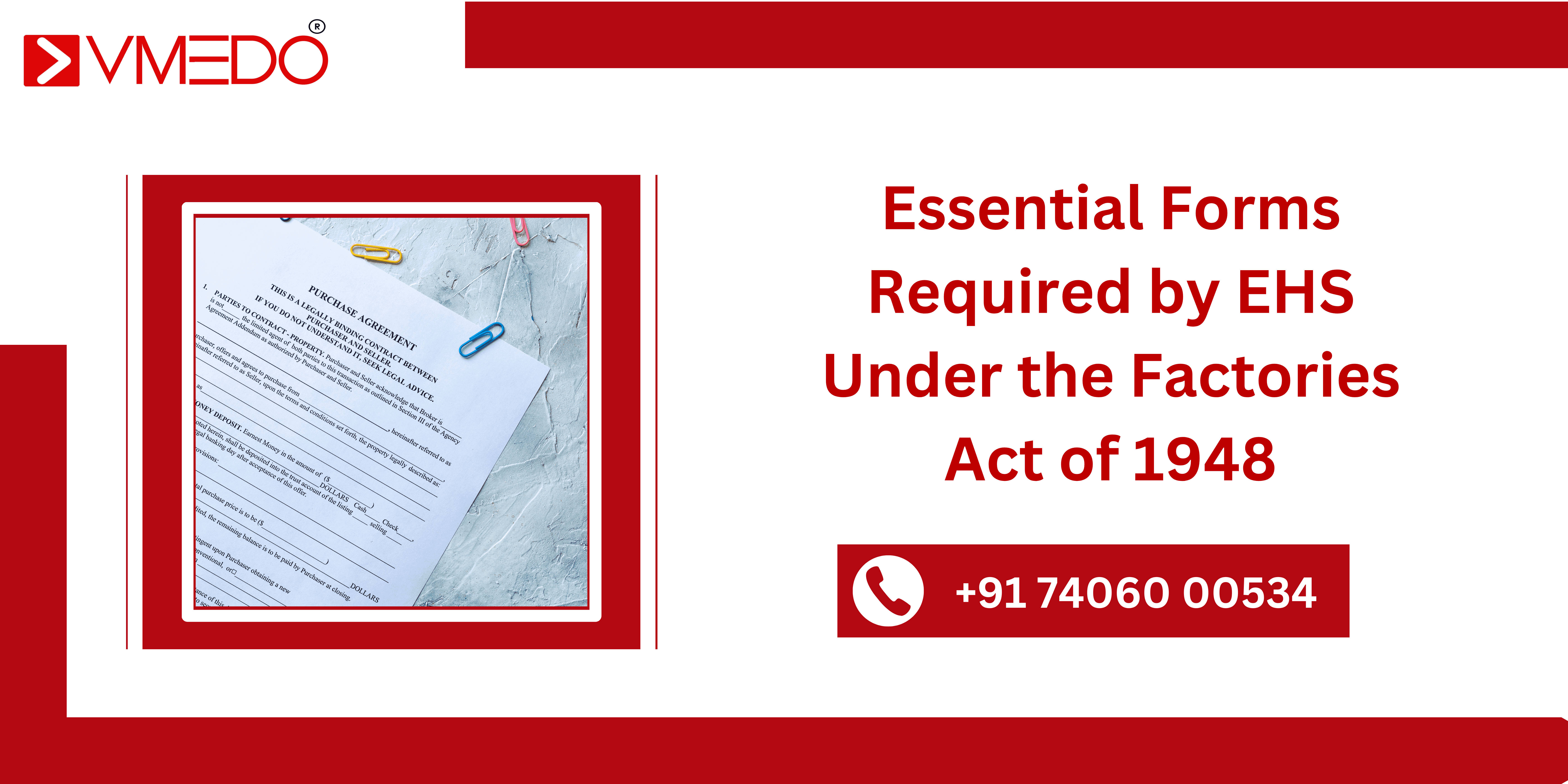The Factories Act of 1948 mandates maintaining key EHS forms to ensure compliance and safeguard worker health and safety. Properly managing these forms, such as health registers, accident logs, and inspection records, helps businesses monitor safety practices, address potential risks, and meet legal obligations, ensuring a well-regulated and safe working environment.
What is the Factories Act 1948?
The Factories Act of 1948 is a law in India that regulates factory labor conditions, ensuring workers’ health, safety, and welfare in industrial establishments. To help factories comply with these regulations, VMEDO offers comprehensive EHS solutions, including Occupational Health Center (OHC) setups and customized training programs.
Key aspects of the Act include:
- Health and Safety: Provisions for clean drinking water, proper lighting, ventilation, and sanitation, which VMEDO can enhance through tailored safety training and assessments.
- Working Hours: Limits on working hours, rest intervals, and overtime pay, ensuring fair labor practices.
- Welfare: Facilities like first aid, canteens, and restrooms for employees, can be effectively managed with VMEDO’s OHC services.
- Protection for Women and Children: Special provisions for their safety and working conditions, ensuring compliance and promoting a safer workplace.
The Act sets out rules for worker rights, accident prevention, and improving workplace environments in factories across India, making VMEDO your trusted partner in navigating these requirements while fostering a culture of safety and well-being among your workforce.
Why are Forms important as per the Factories Act 1948?
Forms mandated by the Factories Act of 1948 are essential for ensuring legal compliance and promoting workplace safety. These forms serve as critical documentation tools that help factories monitor, assess, and improve their Environment, Health, and Safety (EHS) standards. Here’s why these forms are important:
- Health and Safety Monitoring: Forms like health registers and accident logs help track workers’ medical conditions and any incidents, enabling timely interventions.
- Legal Compliance: Maintaining these forms ensures that factories meet the statutory requirements of the Factories Act, helping avoid legal penalties and fines.
- Risk Management: Documenting inspections and accidents helps identify potential risks, allowing factories to take corrective actions and prevent future hazards.
- Inspection Readiness: These records provide necessary data for internal and government inspections, demonstrating adherence to safety regulations.
- Worker welfare: These forms related to working conditions, leaves, and wages protect workers’ rights and foster a fair and safe work environment.
- Transparency and Accountability: Accurate documentation builds transparency in safety practices and holds management accountable for maintaining workplace standards.
Maintaining these forms is not just a legal necessity but also a way to promote a culture of safety, ensuring employees’ well-being and the factory’s smooth operation.
The Factories Act of 1948 mandates that organizations maintain specific forms for effective Environment, Health, and Safety (EHS) management. These forms ensure compliance and help monitor workers’ health and safety. Here are the key forms:
-
Form No. 2 (Application for Factory License)
under the Factories Act of 1948 is the official document required for obtaining a license to operate a factory. This form is essential for ensuring that all factories comply with the legal requirements outlined in the Act before commencing operations.
-
Form No. 4 (Registration and License to Work a Factory)
under the Factories Act of 1948 is a crucial document that grants legal permission to operate a factory. This form encompasses the registration process and the issuance of a license, ensuring that all factories adhere to the necessary regulations for safe and efficient operations.
-
Form No. 8 (Register of Workers Attending to Machinery)
under the Factories Act of 1948 is a critical document used to maintain a record of all workers operating machinery within a factory. This form helps ensure accountability, safety, and compliance with labor regulations regarding machinery operations.
-
Form No. 10 (Register of Compensatory Holidays)
under the Factories Act of 1948 is a vital document used to record compensatory holidays granted to workers. This form helps ensure compliance with labor laws regarding work hours and entitlements, promoting fair treatment of employees.
-
Form No. 16 (Register of Leave with Wages)
under the Factories Act of 1948 is an essential document that records the leave taken by workers while ensuring they receive their wages during this time. This form helps in maintaining transparency and accountability regarding employee leave entitlements and payments.
-
Form No. 17 (Register of Leave with Wages)
under the Factories Act of 1948 is a critical document that records the leave taken by workers, specifically focusing on the leave that is paid. This form is essential for ensuring compliance with labor laws and maintaining fair practices regarding employee leave entitlements.
-
Form No. 19 (Health Register)
under the Factories Act of 1948 is an important document that records the health status and medical examinations of workers in a factory. This form is crucial for ensuring the health and safety of employees and maintaining compliance with legal requirements regarding worker health.
-
Form No. 20 (Accident Form)
under the Factories Act of 1948 is a vital document used to report and document workplace accidents. This form is essential for ensuring accountability, promoting safety, and facilitating proper investigation and response to incidents that occur within the factory premises.
-
Form No. 20A (Notice of Dangerous Occurrence)
under the Factories Act of 1948 is a crucial document used to report any dangerous occurrences that could pose a significant risk to health and safety within a factory. This form is essential for maintaining workplace safety and ensuring compliance with regulatory requirements.
-
Form No. 21 (Notice of Poisoning or Disease)
under the Factories Act of 1948 is an essential document used to report incidents of poisoning or disease that occur among workers within a factory. This form is critical for maintaining worker health and safety and ensuring compliance with legal requirements regarding occupational health hazards.
-
Form No. 29 (Register of Accidents and Dangerous Occurrences)
under the Factories Act of 1948 is a crucial document that serves to record all accidents and dangerous occurrences within a factory. This form is essential for promoting safety, ensuring compliance with legal requirements, and facilitating investigations related to workplace incidents.
-
The Biomedical Waste Disposal Form
is crucial for managing and tracking the disposal of biomedical waste generated in healthcare facilities.
-
The Medical Professional Valid Certificate and License Form
is essential for healthcare practitioners to ensure they are authorized to practice medicine and provide healthcare services. This form typically contains information about the professional’s qualifications, certifications, and licenses.
These forms are crucial for ensuring worker safety and compliance with legal standards. Organizations must maintain these forms for smooth EHS operations.
Frequently Asked Questions (FAQ) on Key EHS Forms Required by the Factories Act of 1948:
-
What is the purpose of Form No. 19 (Health Register)?
Form No. 19 records workers’ health status and medical examinations to help monitor occupational health and ensure compliance with safety regulations.
-
Why are these forms important?
These forms ensure compliance with legal standards, promote worker safety, facilitate monitoring of health and safety conditions, and protect workers’ rights.
-
What is the Biomedical Waste Disposal Form?
The Biomedical Waste Disposal Form documents the handling and disposal of biomedical waste in healthcare facilities, ensuring compliance with waste management regulations.
-
Why is the Biomedical Waste Disposal Form necessary?
It helps in tracking waste management practices, ensuring safe disposal of hazardous materials, protecting public health, and maintaining regulatory compliance.
-
Why is Form No. 21 (Notice of Poisoning or Disease) important?
Form No. 21 is crucial for reporting incidents of poisoning or disease among workers, allowing for timely medical intervention and ensuring compliance with health regulations.
-
How often should these forms be updated?
Update forms regularly, especially after incidents such as accidents, health assessments, or changes in employee status or workplace conditions.
-
What happens if a factory fails to maintain these forms?
Failure to maintain the required forms can lead to legal penalties, fines, and increased scrutiny from regulatory authorities. It may also affect worker safety and rights.
-
What information does the Medical Professional Valid Certificate and License Form contain?
This form includes details about the medical professional’s qualifications, certifications, licenses, and continuing education requirements.
-
Who is responsible for maintaining these forms?
The employer or designated EHS personnel typically maintains and updates all required forms accurately. They ensure these documents remain current and compliant with legal and organizational standards through regular reviews and necessary adjustments.
-
How can employers verify the credentials listed in these forms?
Employers can contact relevant licensing authorities or certification boards to verify the information provided in these forms.
-
What actions should you take if there is a discrepancy in the information provided?
Correct discrepancies immediately and inform relevant authorities or employers to ensure all records remain accurate and compliant.
-
Is there a specific retention period for these forms?
Yes, organizations must retain many forms for a specified period, as mandated by law or policy, typically ranging from 3 to 7 years, depending on the type of document.



